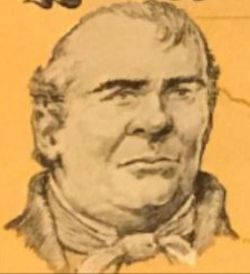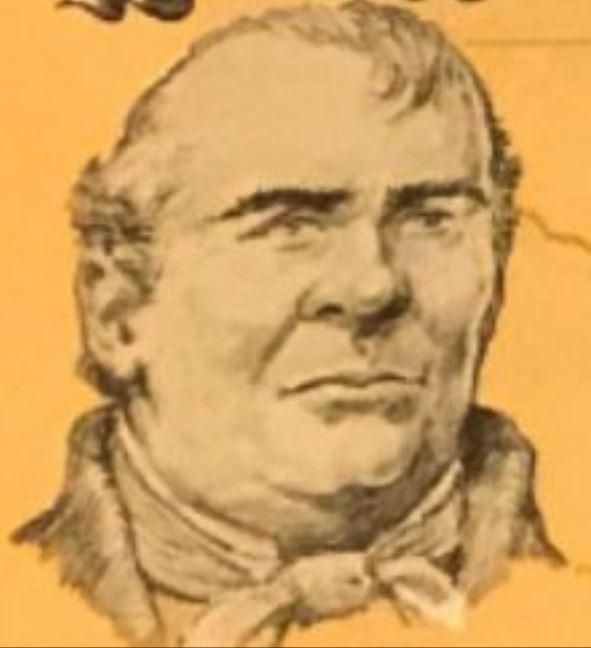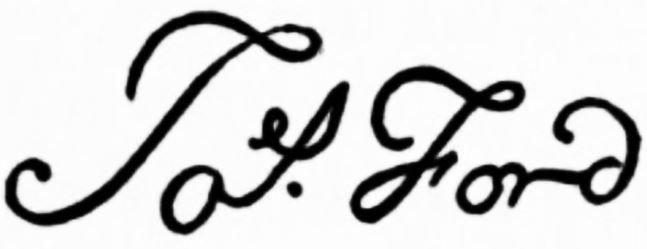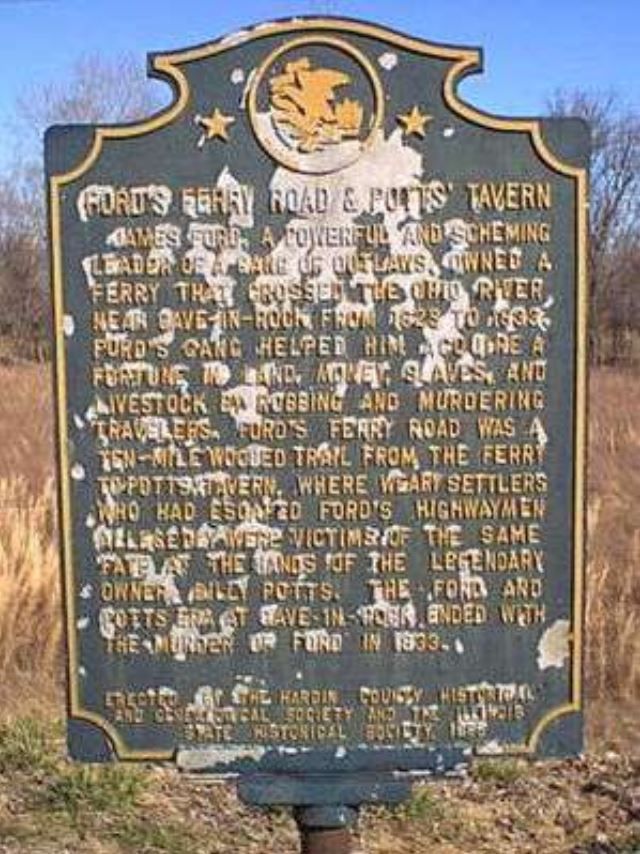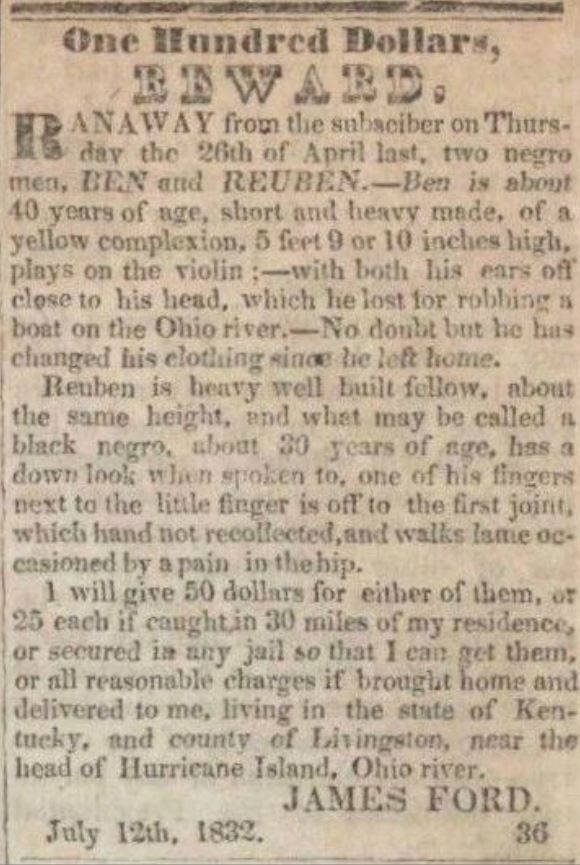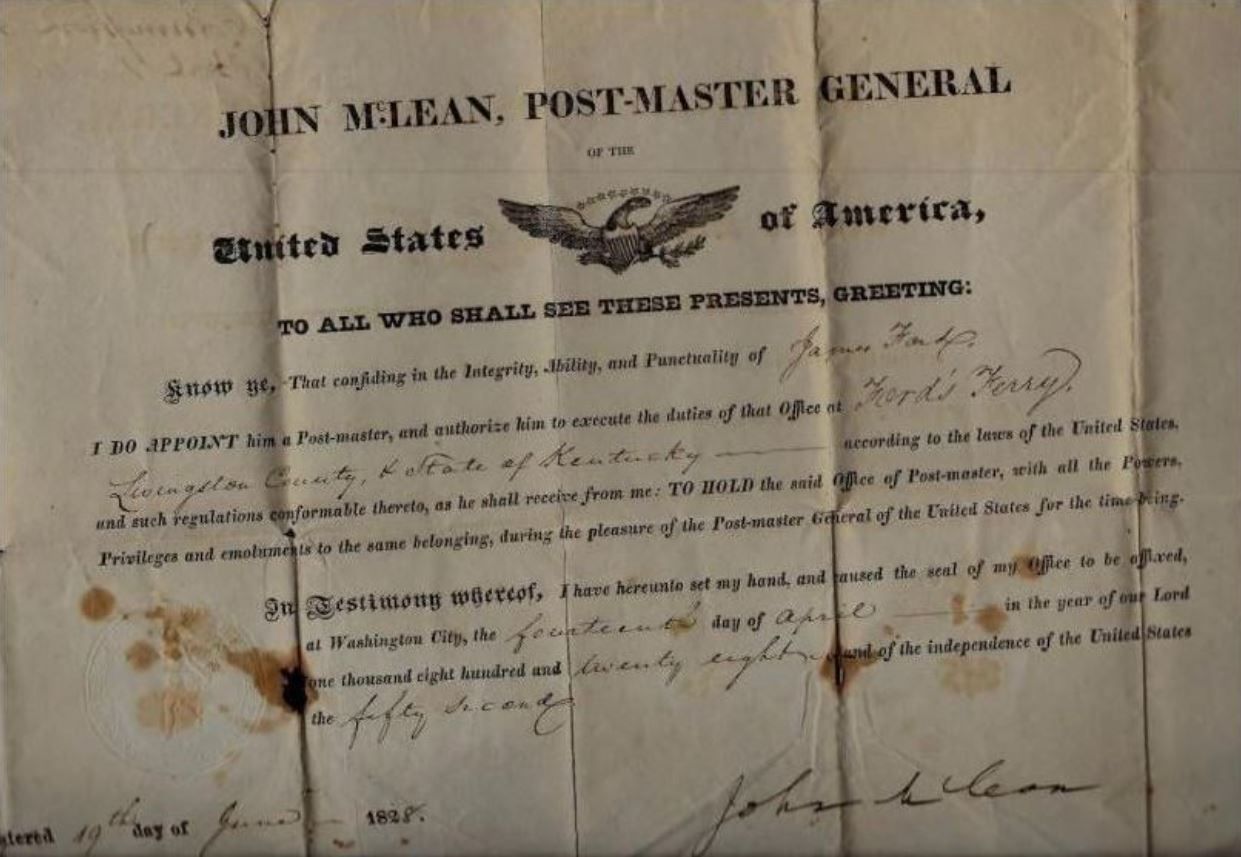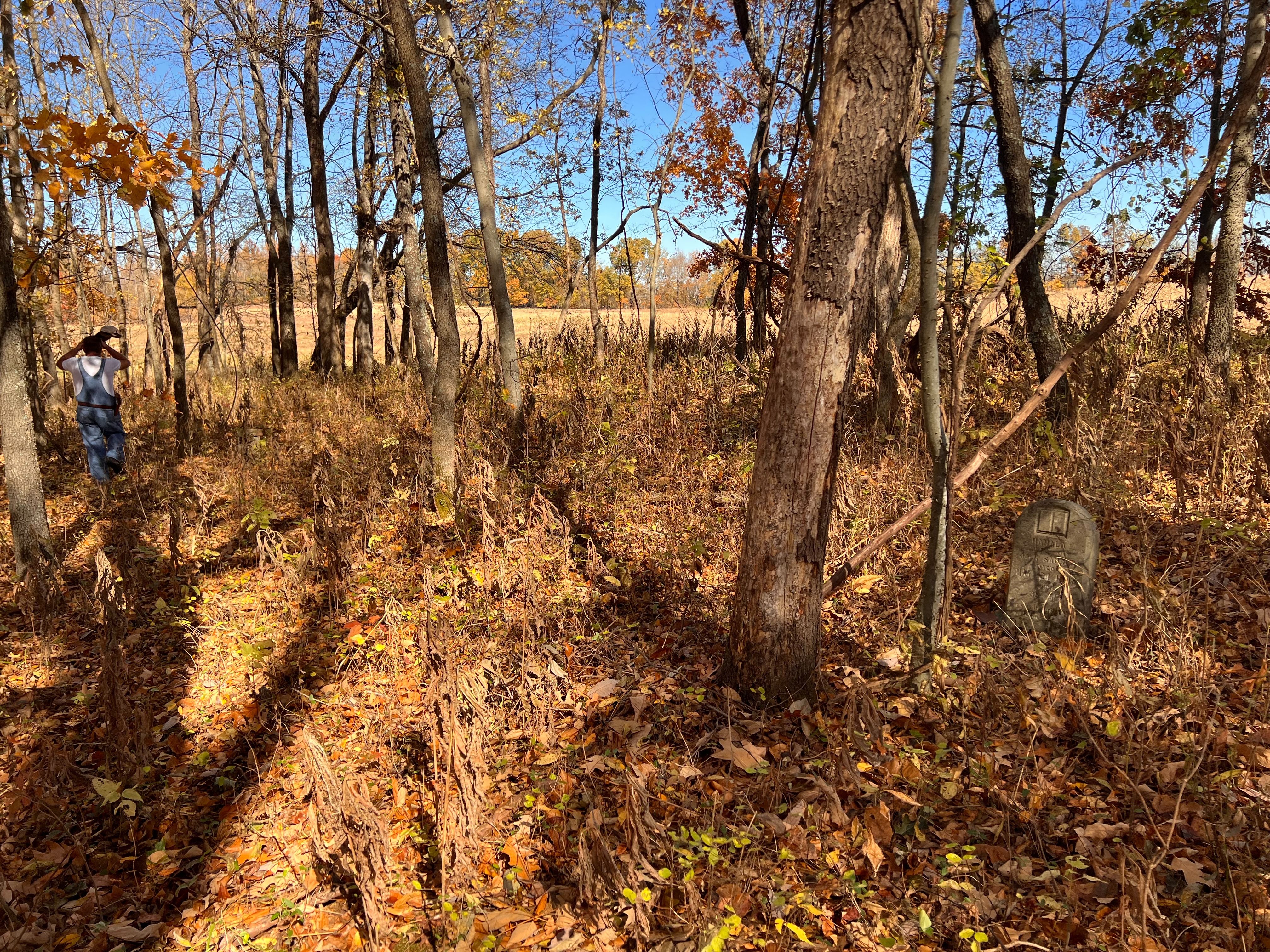American Outlaw and Public Figure. His middle initial of "N" may possibly be for Neal after one of his uncles by that name. The James Ford story is told in the book "Satan's Ferryman" where it is told he was a member of the Fords Ferry Gang. The artist's drawing is based on historical accounts and helps to better identify what he looked like in life. The life of James N. Ford, in the book, "Satan's Ferryman" chronicles the incredible story of his double life as a law-abiding citizen, and pillar of the community and the other as the notorious criminal leader of the Ford's Ferry Gang. In the book, "The Outlaws of Cave-In-Rock", his son-in-law, Dr. Charles Webb described his appearance:
"He was about six feet in height, and of powerful build, a perfect Hercules in point of strength; but he has now grown too corpulent to undergo much fatigue. His head is large and well-shaped; his sandy brown hair, now thin, is turning gray, for he must be fully fifty years old; his eyes, of a steel-gray color, are brilliant and his glance quick and penetrating; his nose rather short and thick; his upper lip remarkably long, his mouth large, and his lips full and sensuous. He has a broad, firm, double chin, and his voice is deep and sonorous. His complexion is very florid, and he converses fluently. On the whole, when in repose, he gives one the idea of a good-natured, rather than a surly, bulldog; but, if aroused, I should say he would be a lion tamer."
Local oral tradition bordering on folklore tells many tales about Ford. Stories conflict about his murder. One is that he was shot by vigilantes. Another was that he was killed by rival members of his outlaw gang. An overview of the life of James Ford was best described in the following epitaph from the book, "The Outlaws of Cave-In-Rock":
"Here lies James Ford, Who did more for the Western Country, Building it up more than all others, But was worse mis-represented, By ungrateful men - his enemies."
The only recorded witnesses to the burial of James Ford at the Ford family burial ground were some of his slaves, his second wife, Elizabeth W. Armstead Frazier-Ford, and ironically one his neighbors, Arthur Love, the son of Colonel Andrew Love who was supposedly murdered in his farm field on the order of James Ford the day before he was to testify as a witness in court against Ford for a crime he may have committed. According to the book, "The Outlaws of Cave-In-Rock", the traditional tale of the funeral and burial of James Ford occurred on a terribly stormy night when his family and slaves brought an oxen-drawn wagon with his coffin to the family cemetery. When the slaves started lowering the coffin into the ground with ropes, a bolt of lightning struck the ground scaring one of them who accidentally dropped the coffin headfirst into the hole and had to leave it permanently wedged in the diagonal position. Because of the heavy rain, the open grave had to be hurriedly filled in. Ford's slaves would say that "Jim Ford land in Hell head foremost." Ford asked his second wife, Elizabeth W. Armstead Frazier-Ford, before he died, that he wanted her to have an inscription on his gravestone to protect his public reputation from being maligned by enemies. According to the book, "The Outlaws of Cave-In-Rock", but because of his wife's sudden death following his, they were buried in unmarked graves as no one got around to creating their gravestones and instead may have marked their gravesites with rocks, which are now long gone. James and Elizabeth were supposedly buried next to his son, William's grave. Other sources indicate that James Ford may have had a stone box grave like his two sons, Philip Ford and William Miles Ford. The two surviving large whole gravestones in the Ford Family Cemetery of Philip and William Ford are stone box graves with heavy, dressed stone slab covers that are six feet long and three feet wide and were originally placed on top of three-foot-high grave boxes. Stone box graves were many times used by prominent, well-to-do families in the early 19th century and were especially popular in the 1820s through the 1830s. According to the official historian of Crittenden County, Kentucky, Brenda Travis-Underdown, years later a local farmer who owned the cemetery land decided to use the stone graves to cover over holes in a nearby pasture but after his child and some of his cows died he thought the Ford gravestones were cursed. The farmer then removed the gravestones and haphazardly dumped them back in the cemetery making the identification and exact locations of the Ford family graves nearly impossible.
Husband of:
(1) Mary Susan Miles, married 1-22-1800, KY.
(2) Elizabeth W. Armstead Frazier, married 1-15-1829, Livingston Co. KY.
Son of Phillip Ford, Sr. and Elizabeth Prince-Ford.
American Outlaw and Public Figure. His middle initial of "N" may possibly be for Neal after one of his uncles by that name. The James Ford story is told in the book "Satan's Ferryman" where it is told he was a member of the Fords Ferry Gang. The artist's drawing is based on historical accounts and helps to better identify what he looked like in life. The life of James N. Ford, in the book, "Satan's Ferryman" chronicles the incredible story of his double life as a law-abiding citizen, and pillar of the community and the other as the notorious criminal leader of the Ford's Ferry Gang. In the book, "The Outlaws of Cave-In-Rock", his son-in-law, Dr. Charles Webb described his appearance:
"He was about six feet in height, and of powerful build, a perfect Hercules in point of strength; but he has now grown too corpulent to undergo much fatigue. His head is large and well-shaped; his sandy brown hair, now thin, is turning gray, for he must be fully fifty years old; his eyes, of a steel-gray color, are brilliant and his glance quick and penetrating; his nose rather short and thick; his upper lip remarkably long, his mouth large, and his lips full and sensuous. He has a broad, firm, double chin, and his voice is deep and sonorous. His complexion is very florid, and he converses fluently. On the whole, when in repose, he gives one the idea of a good-natured, rather than a surly, bulldog; but, if aroused, I should say he would be a lion tamer."
Local oral tradition bordering on folklore tells many tales about Ford. Stories conflict about his murder. One is that he was shot by vigilantes. Another was that he was killed by rival members of his outlaw gang. An overview of the life of James Ford was best described in the following epitaph from the book, "The Outlaws of Cave-In-Rock":
"Here lies James Ford, Who did more for the Western Country, Building it up more than all others, But was worse mis-represented, By ungrateful men - his enemies."
The only recorded witnesses to the burial of James Ford at the Ford family burial ground were some of his slaves, his second wife, Elizabeth W. Armstead Frazier-Ford, and ironically one his neighbors, Arthur Love, the son of Colonel Andrew Love who was supposedly murdered in his farm field on the order of James Ford the day before he was to testify as a witness in court against Ford for a crime he may have committed. According to the book, "The Outlaws of Cave-In-Rock", the traditional tale of the funeral and burial of James Ford occurred on a terribly stormy night when his family and slaves brought an oxen-drawn wagon with his coffin to the family cemetery. When the slaves started lowering the coffin into the ground with ropes, a bolt of lightning struck the ground scaring one of them who accidentally dropped the coffin headfirst into the hole and had to leave it permanently wedged in the diagonal position. Because of the heavy rain, the open grave had to be hurriedly filled in. Ford's slaves would say that "Jim Ford land in Hell head foremost." Ford asked his second wife, Elizabeth W. Armstead Frazier-Ford, before he died, that he wanted her to have an inscription on his gravestone to protect his public reputation from being maligned by enemies. According to the book, "The Outlaws of Cave-In-Rock", but because of his wife's sudden death following his, they were buried in unmarked graves as no one got around to creating their gravestones and instead may have marked their gravesites with rocks, which are now long gone. James and Elizabeth were supposedly buried next to his son, William's grave. Other sources indicate that James Ford may have had a stone box grave like his two sons, Philip Ford and William Miles Ford. The two surviving large whole gravestones in the Ford Family Cemetery of Philip and William Ford are stone box graves with heavy, dressed stone slab covers that are six feet long and three feet wide and were originally placed on top of three-foot-high grave boxes. Stone box graves were many times used by prominent, well-to-do families in the early 19th century and were especially popular in the 1820s through the 1830s. According to the official historian of Crittenden County, Kentucky, Brenda Travis-Underdown, years later a local farmer who owned the cemetery land decided to use the stone graves to cover over holes in a nearby pasture but after his child and some of his cows died he thought the Ford gravestones were cursed. The farmer then removed the gravestones and haphazardly dumped them back in the cemetery making the identification and exact locations of the Ford family graves nearly impossible.
Husband of:
(1) Mary Susan Miles, married 1-22-1800, KY.
(2) Elizabeth W. Armstead Frazier, married 1-15-1829, Livingston Co. KY.
Son of Phillip Ford, Sr. and Elizabeth Prince-Ford.
Gravesite Details
Gravestone missing, gravesite not marked.
Family Members
Advertisement
Explore more
Sponsored by Ancestry
Advertisement
